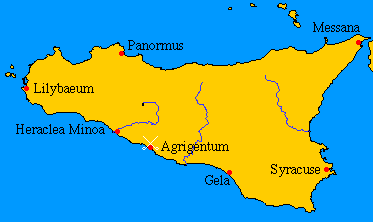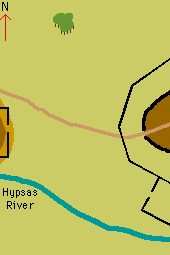Luke Ueda-Sarson's Historical Battle Scenarios for DBM:
The Battle of Agrigentum: 261BC


In 262 BC, the Romans beseiged the important Sicilian city of Agrigentum (Akragas to the Greeks), held by the Carthaginians. Both Roman consuls, Lucius Postumius Megellus and Quintus Mamilius Vitulus, were present, with their combined forces amounting to 40000 men or even somewhat more. They threw a wall of entrenchments around the large city, which was garrisoned by a mixed mercenary force under one Hannibal, son of Gisco.

The Carthaginians gathered a large relief force in Africa, variously stated as numbering from just over 30000 to upwards of nearly 60000 men under Hanno 'the Elder'. After landing in Sicily, he captured the Roman's support depot, so that both beseiged and besiegers started to suffer greatly. Luckily for the Romans, their ally, Hiero of Syracuse, kept them supplied with essential provisions.
After the sixth month of the seige, feeling the pinch, the Romans accepted a pitched battle with Hanno. Little details are available, and they are contradictory. It seems that Hanno's mercenaries were pushed back on his elephants, which in turn disordered the rest of the army. Zonares has a Roman ambush take the Carthaginians in the rear while a sorty from the garrison was beaten off; Frontinus (in his Strategems, 2.1.4) has the Romans waiting patiently inside their entrenchments while the Carthaginians tired themselves out.
In any event, while the Carthaginians were beaten, their losses seem to have been quite minor, and the garrison broke out through the entrenchments to freedom while the Romans celebrated their success. Perhaps this is why the consuls were refused a triumph, despite capturing the now garrisonless city, in a war that saw many triumphal awards.

Megellus' forces seem to have been more important in the fighting than Vitulus' (or so we assume in that Frontinus mentions the first, not the latter), so he should be represented as the Roman C-in-C. As a large part of the Roman forces had to man the entrenchments guarding the city, they were not available to fight the battle. Vitulus should therefore be represented as a Roman allied general.
Similarly, Hannibal should be represented as a Carthaginian ally general - he could only communicate with Hanno by smoke signals and the like, and could not effectively coordinate his forces with the relief army.
At 500 men per element, the forces can be conjectured thusly:
The Romans:
Megellus' legion and allied legion:
6 x Reg Ps (S) - Velites (see notes below)
6 x Reg Bd (O) - Hastatii
6 x Reg Bd (O) - Principes
3 x Reg Sp (S) - Triarii
1 x Reg Cv (O) - Equites
1 x Lucius Postumius Megellus - Reg Cv (O) C-in-C
Megellus' second Roman and allied legions:
6 x Reg Ps (S) - Velites
6 x Reg Bd (O) - Hastatii
6 x Reg Bd (O) - Principes
2 x Reg Sp (S) - Triarii
1 x unnamed Roman quaestor or tribune - Reg Sp (S) sub-general
2 x Reg Cv (O) - Equites
6 x Irr Bg (I) - supplies in the camp
Vitellus' forces spared from watching the city:
6 x Reg Ps (S) - Velites
6 x Reg Bd (O) - Hastatii
6 x Reg Bd (O) - Principes
2 x Reg Sp (S) - Triarii
1 x Quintus Mamilius Vitulus - Reg Cv (O) ally-general
2 x Reg Cv (O) - Equites
The Carthaginians:
Hannibal's garrison sorty-party:
3 x Irr Ax (O) - Ligurians
3 x Irr Bd (I) - Celts (see notes below)
4 x Irr Ax (S) - Spaniards
2 x Irr Ps (S) - Spaniards
1 x Irr Ps (O) - Spaniards
1 x Hannibal - Reg Cv (O) ally-general
The relief army:
1 x Hanno - Reg Cv (O) C-in-C
1 x unnamed sub-general - Reg Cv (O)
6 x Irr Bg (I) - baggage in the camp
2 x Irr El (I) - Elephants
6 x Irr LH (O) - Numidians
8 x Reg Sp (O) - Libyans
The rest of the relief army is determined randomnly, drawing 32 cards from a regular deck of 52 playing cards, plus 1 joker:
Black two: Irr LH (O) - Spaniard horsemen
Red two: 2 x Irr Ps (O) - Moorish archers or Balearic slingers
Black three: 4 x Irr Bd (I) - Celtic swordsmen
Red three: 2 x Irr Ax (O) - Ligurians
Four: 2 x Irr Ps (S) - Numidian javelinmen
Five: Irr El (I) - African Elephants
Six: Irr Bd (I) - Celtic swordsmen
Seven: Nothing!
Eight: 2 x Irr Ax (S) - Iberian infantry
Nine: 2 x Reg Sp (O) - Libyan Spearmen
Ten: 2 x Reg Sp (I) - Siciliot Greeks
Jack: Irr LH (O) - Numidian horsemen
Queen: 2 x Reg Sp (O) - Libyan spearmen
Black King: 2 x Reg Ax (S) - Mercenary Thureophoroi
Red King: 2 x Reg Sp (O) - Mercenary Hoplites
Black Ace: Irr Cv (O) + Irr Ps (S) - Spanish cavalry and supporting caetrati
Red Ace: Reg Cv (O) - Poeni cavalry
Joker: Reg Cv (O) sub-general


|
Fighting the battle:
The Carthaginian relief force faces due east, with the garrison inside the city. The season is winter. Determine the battle start time and weather in the usual manner. The Carthaginians should count as the 'invader', and so take the first move. All allies have already been proven as reliable. The western edge of the acropolis of the city is situated on a steep plataeu, and should thus be represented by permanent fortifications with on a flat-topped steep-sided hill in the middle of the Roman's deployment area to the east. A road leads from the acropolis' gate westwards to Himera Minoa. The Toros hill the Carthaginians have their fortified camp on counts as gentle all round. Roman entrenchments surround the city facing inwards. In addition, Megellus' camp is represented in the south. The Hypsas river is small (depict it as less than 50p wide), and fordable in any formation, but at reduced movement rate. As the Romans count as the 'defender', they may place an ambush in the small wood to the north. Megellus' men deploy in the south of the city, Vitulus' to the north. No flank marches are allowed (the southern flank is blocked by the sea, and the north approaches to the city are easily visible to both sides). |
Notes and special rules:
Velites are currently allowed in the DBM lists only post 210 BC, but this is based on an impossibly self-contradictory passage in Livy (26.4). Livy records their use before this date (and Lucilius that of Rorarii after this date!). If there was a significant change from Rorarii to Velites, it ought to be dated to 275 BC in line with the other changes in the switch-over from the 'Camillan' to the 'Polybian' system. Velites were not noticeably inferior to their Carthaginain opposites (which they would be as Ps (I)!), and Pyrrhus certainly had large numbers of shielded light infantry to serve as a model. Finally, the velites should not give rear support to their cavalry, as this ability is based on this same corrupted passage in Livy were they ride the cavalry's horses - only there are not enough horses to go around!
Celts are graded as Bd (I) in their mercenary role since there is no evidence of them charging furiously warband-style, either now, later, under Hannibal (the 'REAL' one, in Italy!), or before, serving under the Syracusans in Greece. Since they were purely swordsmen, but unarmoured, they are graded (I), and not (F) - since they would then be impetuous.

